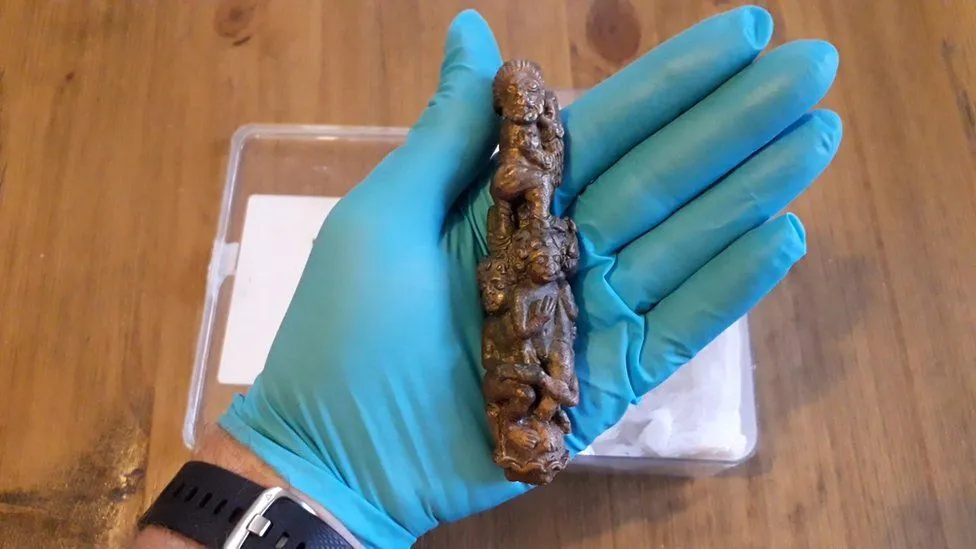Did Officials in Roman Britain Throw Condemned Prisoners to the Lions?
A key handle unearthed in Leicester suggests executions in imperial colonies involved wild animals
:focal(392x217:393x218)/https://tf-cmsv2-smithsonianmag-media.s3.amazonaws.com/filer/a7/a0/a7a0138a-89ce-44f9-83c1-f31b31992ae2/lionsss.jpg)
Archaeologists in Leicester, England, say a bronze key handle depicting a lion fighting a man may reflect real executions that took place in Britain under Roman rule.
“This unique object gives us our most detailed representation of this form of execution found in Roman Britain,” says John Pearce, an archaeologist at King’s College London, in a statement. “As the first discovery of this kind it illuminates the brutal character of Roman authority in this province.”
Pearce and two colleagues published their analysis of the artifact in the journal Britannia this week.
Researchers from the University of Leicester Archaeological Services (ULAS) found the object, which measures more than four inches long, while excavating a Roman town house in 2017, reports BBC News. They dated it to around 200 C.E. The dig also uncovered Roman streets, mosaic floors and a theater.
“When first found, it appeared as an indistinguishable bronze object, but after we carefully cleaned off the soil remarkably we revealed several small faces looking back at us, it was absolutely astounding,” says co-author Gavin Speed, who led the excavations for ULAS, in the statement. “Nothing quite like this has been discovered anywhere in the Roman Empire before.”
The handle depicts a man fighting a smaller-than-life lion. Below the fight, four naked youths huddle in fear. The man’s appearance—shirtless, with long hair and a big beard—is suggestive of a “barbarian,” or someone not of Roman origin, writes Sarah Cascone for Artnet News.
Roman law allowed criminals and prisoners of war to be thrown to wild beasts. This punishment, known as damnatio ad bestias, served as a form of public entertainment and was often used to symbolize the destruction of Rome’s enemies. But until now, scholars had little evidence that the practice took place in Britain, far from the empire’s center.
The Romans imported lions from Mesopotamia and North Africa to fight at the Colosseum, housing the animals in imperial parks. As Pearce tells the London Times’ Nicholas Hellen, it’s possible the Romans transported some of the creatures to Britain, too.
“You can imagine a journey by sea, probably to the mouth of the River Rhône, with the lion caged on board ship, up river to Lyons then probably a wagon journey to the River Rhine, down river and across the North Sea to London or the mouth of the Humber,” he says.
Speaking with Live Science’s Laura Geggel, Pearce says the artifact’s style suggests it was made locally.
“It is also not a standard genre scene of the type seen elsewhere in Roman art, so we suggest it marks a specific event, perhaps one seen in the province,” he explains.

The Romans built many amphitheaters in Britain. Typically, spectacles at these venues would have involved local animals like bulls, bears and stags. The appearance of an imported lion, notes Pearce, would have “lived long in the memory” and could have prompted the creation of the key handle.
Pearce says the find has encouraged researchers to reexamine a fourth-century mosaic found in North Yorkshire in 1933 that features a lion and other exotic animals.
“It has always intrigued people because it’s got a scene that looks really out of place,” he tells the Times. “[I]t looks like a botched version of something you might find in North Africa.”
Researchers had previously assumed that the mosaic was simply a copy of art made in North Africa—but it’s possible the work actually depicts animals imported to Britain.
The key handle will go on display at the Jewry Wall Museum in Leicester upon completion of a refurbishment project in 2023.
“It’s one of the most exciting finds we’ve had in Roman Leicester and it’s got a great story to tell about life in Roman Leicester and the potential evidence it gives for activities that might have taken place in the theatre, or possibly an amphitheater that we haven’t discovered yet,” co-author Nick Cooper, an archaeologist at ULAS, tells BBC News.
/https://tf-cmsv2-smithsonianmag-media.s3.amazonaws.com/accounts/headshot/Livia_lg_thumbnail.png)


/https://tf-cmsv2-smithsonianmag-media.s3.amazonaws.com/accounts/headshot/Livia_lg_thumbnail.png)